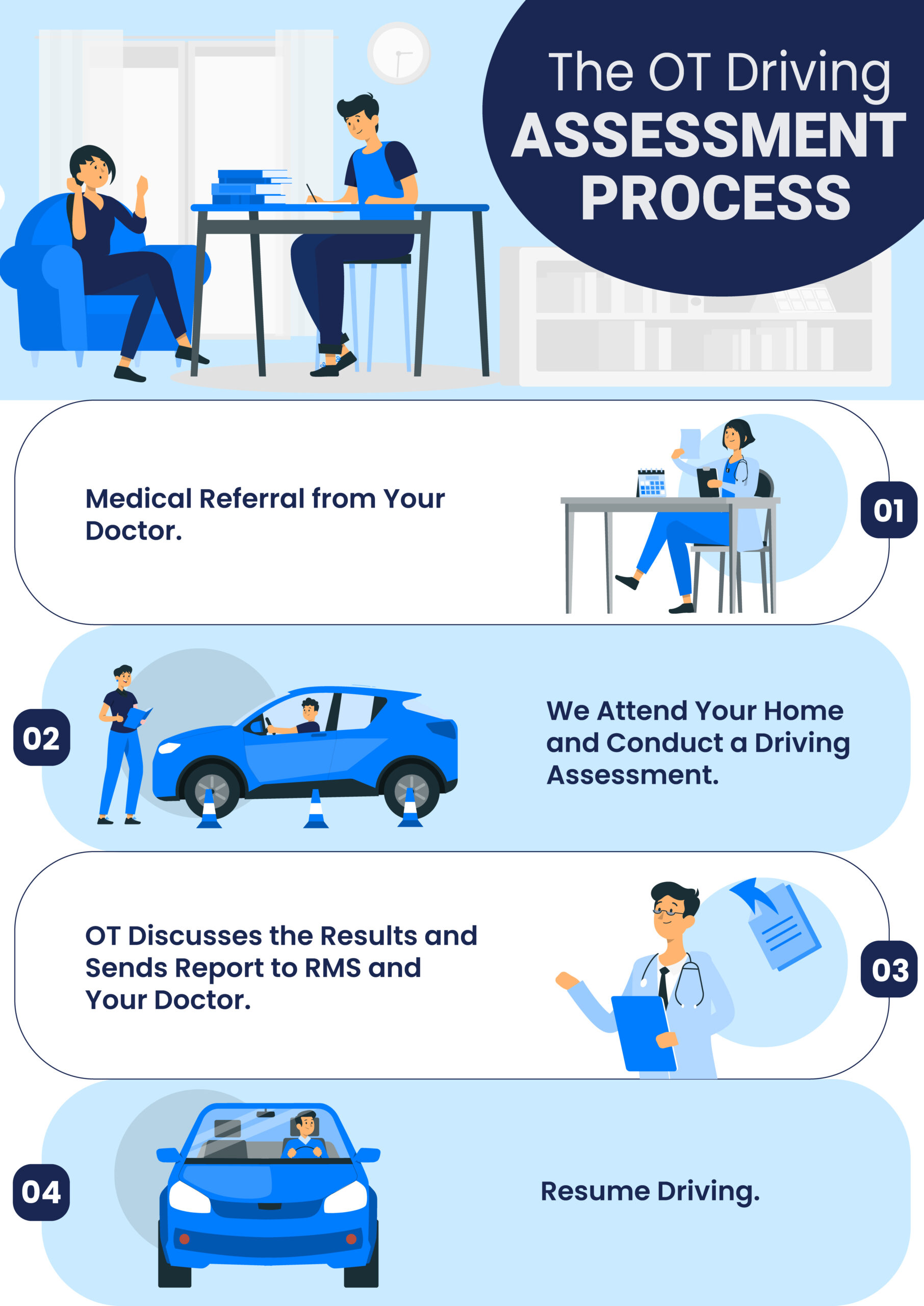As an occupational therapist (OT) or a driver with a medical condition, understanding the intricacies of driving assessments isn’t just practical – it’s a crucial part of ensuring that individuals can drive safely, conform to legal standards, and, in many cases, retain their independence. To explore this, we delve into the legal framework, safety considerations, and the nuanced challenges faced when evaluating driving skills.

Taking the Wheel: Legal Framework and Regulations
If you have a medical condition that could impact your driving, consult with a healthcare professional before getting behind the wheel. Conditions that necessitate such consultation include blackouts, vision impairment, heart disease, stroke, epilepsy, cognitive decline including dementia, sleep disorders, diabetes, neurological issues, mental health conditions, or any substance misuse. These issues have the potential to impair driving abilities and can make operating a vehicle unsafe for both the driver and others on the road.
In NSW, people driving (or have passengers) with a disability is on the rise, with about 417,000 disability parking permits recorded in March 2023. Thus, evaluating an individual’s medical fitness to drive involves a complex web of legalities, including:
- Interpreting medical reports and legal forms issued by healthcare providers
- Complying with the standards set by Transport of NSW (RMS)
- Understanding the nuanced requirements for different kinds of driver’s licenses, e.g., private or commercial
Your doctor or specialist will determine whether your condition allows you to drive safely and may provide recommendations or restrictions to adhere to. Compliance with medical advice is paramount to maintaining safety standards on the road.
License to Drive: Reporting a person’s Medical Condition
For NSW drivers, reporting any medical condition or recent surgery affecting your capacity to drive to RMS is mandatory. The RMS should be informed immediately after the onset of the condition, not just at licence renewal. Ultimately, it is the responsibility of the licence holder to make this notification, although many people are unaware of this requirement. A family member or friend may also alert the RMS. However, usually the RMS notification of medical conditions or disability comes from the person’s doctor.
Once the medical issue becomes known by RMS, the person will typically get a notification in the post requesting a medical assessment to determine fitness to drive. This letter specifies the type of medical professional to consult (e.g. GP or specialist), sets the assessment deadline, and indicates if a driving test is mandatory. It is essential to respond promptly and meet allocated deadlines to avoid license suspensions.
The Road to Safety: the OT driving assessment
The next step following medical assessment may be obtaining an OT driving assessment. In this assessment, specialised OTs look the person’s functioning in the following areas:
- Vision and perception
- Cognition, reaction time and decision-making
- Motor functions
- Emotional and psychological factors
Each of these components must be assessed thoroughly, through a combination of clinical evaluation and an on-road driving assessment. The driving evaluation looks at how your medical condition is impacting on your driving.
Post-Assessment Outcomes and Recommendations
After the OT driving assessment, there are three possible outcomes. If you’re driving safely, your license remains valid. If the assessment uncovers errors, you may need driving lessons followed by a re-test. For people with physical limitations that affect driving, the OT will prescribe vehicle modifications (and usually driving lessons) so they can drive to legal conventions. In cases where driving safety is severely compromised, your license could be cancelled. The OT will provide detailed feedback and next steps based on their evaluation of your driving abilities. Prompt attention to these recommendations is vital for your safety and legal compliance.
After the Assessment: The Report
Following the driving assessment, the OT will create the report outlining what happened in the assessment, results and their recommendations. This report is sent to Transport for NSW, as well as the person’s referring GP or specialist. The client will also get a copy of the report, as well as any other stakeholder such as the NDIS or insurance company.
Enhancing Driving Skills: Driving Lessons
Specialised driving lessons, tailored to correct identified deficits, may be recommended by the OT post-assessment. They focus on improving specific skills and areas of difficulty demonstrated during the assessment, ensuring the driver meets legal standards. Lessons can often be funded through the National Disability Insurance Scheme (NDIS) or insurance providers, offering financial support for those eligible. It’s vital to review insurance and NDIS plans to understand coverage for these essential services. Quick action, guided by the OT’s recommendations, facilitates a safe return to driving.
Overcoming Physical Disability: Vehicle Modifications
Vehicle modifications and adaptive equipment are critical for drivers with physical disabilities to operate vehicles safely and comfortably. These custom changes can include hand controls, steering aids, or pedal extenders. RMS requires that such modifications meet specific safety regulations. Specialised driving lessons then equip drivers to use these alterations effectively. Additionally, RMS often requires a disability driving test, assessing modified vehicle handling and the driver’s ability to adhere to current road rules.
Putting it All Together
In summary, ensuring road safety for drivers with medical conditions or disabilities involves stringent assessment and compliance with legal standards. The key steps—reporting conditions, attending medical evaluations and OT driving assessments, and adhering to recommended outcomes—cannot be overlooked. Specialised driving lessons and vehicle modifications further support individuals in meeting the required safety protocols. It’s essential to act promptly, report accurately, and follow through with OT guidance and RMS regulations. The process is thorough but vital for personal and public safety on NSW roads. Always consult medical professionals and RMS promptly to maintain your driving privileges and ensure road security for all.
Learn more about our NDIS driving assessments.
Contact us today to get started.



